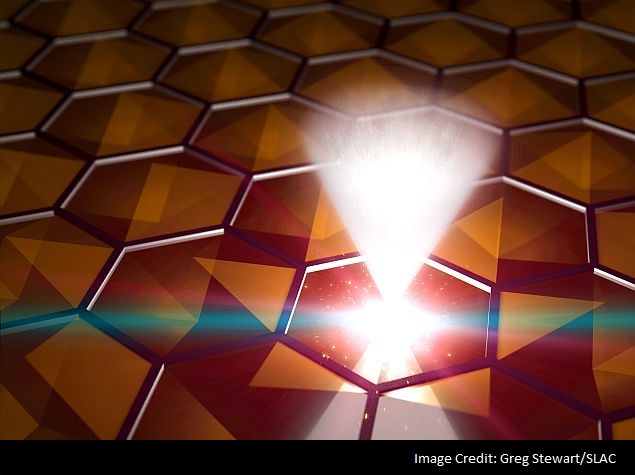- Home
- Science
- Science News
- Scientists Find Wonder Material to Replace Graphene
Scientists Find Wonder Material to Replace Graphene

Scientists have found a material that has the same extraordinary electronic properties as 2D graphene but in a sturdy 3D form, a discovery that may lead
to new and faster types of electronic devices.
The material, cadmium arsenide, is being explored independently by three groups, one of which includes researchers at the University of Oxford, SLAC National Accelerator Laboratory, Stanford and Lawrence Berkeley National Laboratory.
Led by Yulin Chen of the University of Oxford, the group's work builds on its earlier studies of a sodium bismuth compound that also mimics graphene but turns to powder when exposed to air.
Co-authors Zhong Fang and Xi Dai, theoretical physicists from the Chinese Academy of Sciences, had predicted both compounds and suggested that cadmium arsenide, which is used in detectors and sensors, would provide the same properties in a much more stable form.
Their prediction proved correct, said Zhongkai Liu, the paper's first author and a graduate student at SIMES, the Stanford Institute for Materials and Energy Sciences at SLAC.
"The environmental stability of cadmium arsenide allows us to explore it very systematically, and makes it easier to study," he said.
Researchers are searching for graphene-like materials that are three-dimensional, and thus much easier to craft into practical devices.
Chen's group made samples of cadmium arsenide at Oxford and tested them at the Diamond Light Source in the UK and at Berkeley Lab's Advanced Light Source.
"We think this family of materials can be a good candidate for everyday use and we're working with theorists to see if there are even better materials out there," Chen said.
The research was published in the journal Nature Materials.
Catch the latest from the Consumer Electronics Show on Gadgets 360, at our CES 2026 hub.
Related Stories
- Samsung Galaxy Unpacked 2025
- ChatGPT
- Redmi Note 14 Pro+
- iPhone 16
- Apple Vision Pro
- Oneplus 12
- OnePlus Nord CE 3 Lite 5G
- iPhone 13
- Xiaomi 14 Pro
- Oppo Find N3
- Tecno Spark Go (2023)
- Realme V30
- Best Phones Under 25000
- Samsung Galaxy S24 Series
- Cryptocurrency
- iQoo 12
- Samsung Galaxy S24 Ultra
- Giottus
- Samsung Galaxy Z Flip 5
- Apple 'Scary Fast'
- Housefull 5
- GoPro Hero 12 Black Review
- Invincible Season 2
- JioGlass
- HD Ready TV
- Laptop Under 50000
- Smartwatch Under 10000
- Latest Mobile Phones
- Compare Phones
- OPPO Reno 15 Pro Max
- Honor Win RT
- Honor Win
- Xiaomi 17 Ultra Leica Edition
- Xiaomi 17 Ultra
- Huawei Nova 15
- Huawei Nova 15 Pro
- Huawei Nova 15 Ultra
- Asus ProArt P16
- MacBook Pro 14-inch (M5, 2025)
- OPPO Pad Air 5
- Huawei MatePad 11.5 (2026)
- Xiaomi Watch 5
- Huawei Watch 10th Anniversary Edition
- Acerpure Nitro Z Series 100-inch QLED TV
- Samsung 43 Inch LED Ultra HD (4K) Smart TV (UA43UE81AFULXL)
- Asus ROG Ally
- Nintendo Switch Lite
- Haier 1.6 Ton 5 Star Inverter Split AC (HSU19G-MZAID5BN-INV)
- Haier 1.6 Ton 5 Star Inverter Split AC (HSU19G-MZAIM5BN-INV)
















